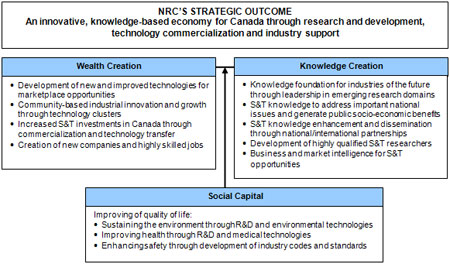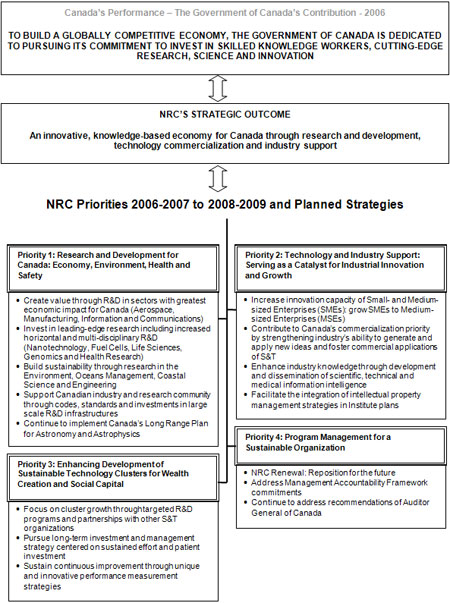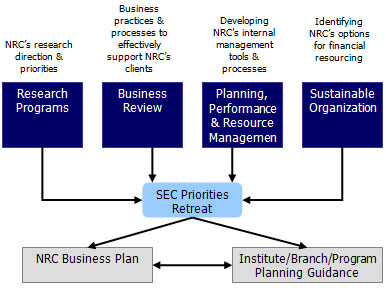Common menu bar links
Breadcrumb Trail
ARCHIVED - National Research Council Canada
 This page has been archived.
This page has been archived.
Archived Content
Information identified as archived on the Web is for reference, research or recordkeeping purposes. It has not been altered or updated after the date of archiving. Web pages that are archived on the Web are not subject to the Government of Canada Web Standards. As per the Communications Policy of the Government of Canada, you can request alternate formats on the "Contact Us" page.
Section I: Agency Overview
Minister's Message
 |
I am pleased to present the National Research Council's Departmental Performance Report for 2006 – 07.
My goal as Minister of Industry, and one of the top priorities of Canada's New Government, is to ensure we maintain a strong economic environment — one that allows Canadians to prosper in the global economy. We are seeing great changes in the international marketplace. New trade agreements, rapidly advancing technologies and the emergence of developing countries are all contributing to today's business environment. Canada needs to keep pace.
Part of my mandate is to help make Canadians more productive and competitive. We want our industries to continue to thrive and all Canadians to continue to enjoy one of the highest standards of living in the world.
For this to happen, the government is committed to maintaining a fair, efficient and competitive marketplace — one that encourages investment, sets the stage for greater productivity, and facilitates innovation. We are relying on market forces to a greater extent, regulating only when it is absolutely necessary. Our policies have helped turn research into new products and business processes. In addition, we are making efforts to increase awareness of sustainability practices among Canadian industry, emphasizing the social, environmental and economic benefits they bring.
The Department and the Industry Portfolio have made progress on a wide range of issues this past year, most notably in the areas of telecommunications, science and practical research, manufacturing, small business, consumer protection, patents and copyrights, tourism and economic development.
The Industry Portfolio is composed of Industry Canada and 10 other agencies, Crown corporations and quasi-judicial bodies. These organizations collectively advance Canada's industrial, scientific and economic development, and help ensure that we remain competitive in the global marketplace.
We have accomplished much this year. Using Advantage Canada — the government's long-term economic plan — as our roadmap, we have made great strides toward many of our most important goals. We will continue to focus on these goals to support the conditions for a strong economy — an environment that Canadians expect and deserve.
Jim Prentice
Minister of Industry
Management Representation Statement
|
I submit, for tabling in Parliament, the 2006 – 2007 Departmental Performance Report for the National Research Council Canada.
Dr. Pierre Coulombe |
National Research Council's (NRC's) Business (Summary Information)
Raison d'�tre
NRC is the Government of Canada's leading resource for Science and Technology (S&T) development. NRC's primary business is:
- improving the social and economic well-being of Canadians;
- providing technology and industry support for industrial innovation and growth; and
- supplying excellence and leadership in research and development (R&D).
NRC Benefits to Canadians
NRC delivers on its strategic outcome by creating wealth, knowledge and social capital for Canadians.
Figure 1-1: NRC Benefits to Canadians

NRC's Business and Management Priorities for 2006-2007 – Status on Performance
Table 1-1: NRC Resources for 2006-2007
| Financial Resources ($ millions) | ||
|
Planned |
Total Authorities |
Actual Spending |
|
714.1 |
844.7 |
742.1 |
|
Human Resources (Full-Time Equivalents – FTEs) |
||
|
Planned |
Actual |
Difference |
|
4,033 |
4,191 |
158 |
Figure 1-2 highlights the plans and priorities identified in the 2006-2007 to 2008-2009 period (as identified in NRC's 2006-2007 Report on Plans and Priorities (RPP)).
Figure 1-2: Strategic Framework for NRC Plans and Priorities

Table 1-2: NRC Business and Management Priorities for 2006-2007
|
NRC's Strategic Outcome: |
Performance Status* |
2006-2007 |
||
|
Priorities and Type |
Program Activity/ Expected results |
Planned spending |
Actual spending |
|
|
Priority no. 1 Type: ongoing |
Program Activity: Research and Development |
successfully met |
390.66 |
380.8 |
|
Expected results:
|
||||
|
Priority no. 2 Type: ongoing |
Program Activity: Technology and Industry Support |
successfully met |
179.22 |
182.2 |
|
Expected Results:
|
||||
|
Priority no. 3 Type: previously committed |
Program Activity: Research and Development and Technology and Industry Support |
successfully met |
75.89 |
75.2 |
|
Expected Results:
|
||||
|
Priority no. 4 Type: ongoing |
Program Activity: |
successfully met |
68.28 |
103.9 |
|
Expected Results:
|
||||
* It should be noted that the Expected Results identified in the 2005-2006 RPP apply to a three-year period and therefore not all listed results have been successfully met in the 2005-2006 fiscal year; however, overall the priority is considered "successfully met".
** Program Activities' contributions to this priority are significantly supported by NRC's Corporate Branches which provide policy, program advice and executive support for the coordination and direction of NRC's operations and its Council. The Corporate Branches also specialize in finance, information management, human resources, administrative services and property management, and
corporate services.
NRC's Operating Environment
NRC has:
- A national S&T infrastructure positioned to: improve Canada's innovation capacity in existing and emerging fields of research; build networks for researchers and businesses; train highly qualified personnel; create new technology-based companies and jobs; and transfer knowledge and technology to Canadian companies.
- A core strength of over 4,000 talented and dedicated people, 19 research institutes, 15 industrial partnership facilities, the Industrial Research Assistance Program (NRC-IRAP), the Canada Institute for Scientific and Technical Information (NRC-CISTI) and two technology centres.
- The ability to help companies move discoveries in the laboratory towards the development, prototyping and commercialization of these ideas and technologies for the global marketplace.
- The skills to manage research towards short- and long-term specific goals.
- The capability to bring together multi-disciplinary research teams to tackle issues of national importance.
- The ability to put together national programs for delivery in regions across the country.
National S&T Infrastructure
NRC delivers a national S&T program with laboratories, centres and facilities in communities across Canada (http://www.nrc-cnrc.gc.ca/contactIBP_e.html).
Ownership, Management and Maintenance of Capital Assets
Responsible for its own highly technical and complex operations, NRC manages 175 buildings totalling approximately 517,406 square metres of space.
Funding
NRC is funded through government appropriations. In the course of providing technical services to companies and other organizations, it recovers its costs for the purpose of reinvesting in the operation and maintenance of equipment and facilities.
Context
Internal Factors
NRC New Strategic Direction: Building a Roadmap for Future Sustainability
The 2006-2007 fiscal year began with the official release of NRC's new strategy, Science at Work for Canada: A Strategy for the National Research Council, 2006-2011. Shortly thereafter, the organization put in place four major implementation initiatives composed of cross-functional teams with the requisite subject-matter expertise:
- Research Programs
- Business Review
- Planning, Performance & Resource Management (PPRM)
- Sustainable Organization
As illustrated below, these implementation teams made recommendations that were presented to the Senior Executive Committee (SEC) in fall 2006 as part of NRC's annual priority setting exercise. Decisions reached by SEC served as key inputs into the development of NRC's inaugural corporate business plan, a draft of which was developed by the end of fiscal year 2006-2007. A final version of the NRC corporate business plan is expected to be in place by early 2007-2008.
Figure 1-3: NRC's Strategy Implementation Process

The following summarizes the implementation teams' key recommendations that were approved by SEC:
Research Programs
NRC will focus its R&D efforts in nine key industrial sectors: Aerospace, Agriculture, Automotive, Chemicals, Construction, Electronic Instruments, Information and Communications Technologies, Manufacturing & Materials and Bio-Pharma. These sectors were identified through significant quantitative and qualitative analysis, as well as through consultation with internal and
external stakeholders that took place throughout 2006-2007. Each NRC research vice-president (VP) was assigned accountability for one or more sectors. Beginning in 2007-2008, Directors General (DGs) will be appointed to lead the development of plans and objectives for each sector.
In addition, NRC will work closely with other government departments, industry and universities to address national priorities in health & wellness, sustainable energy and the environment. As a first major initiative, NRC is committed, in cooperation with Agriculture and Agri-food Canada, to putting in place a national program in bioproducts which will address those latter two national priorities. An accountable VP, a lead DG and a working group have been assigned to the development of the National Bioproducts Program and a target date of Q1 2008-2009 has been established for full launch of the National Bioproducts Program.
NRC has also identified an opportunity to establish a second national program in Fuel Cells & Hydrogen, building on an existing cross-NRC program. A target of 2009-2010 has been set as the formal launch date for the program, although planning work will begin in earnest in 2007-2008.
Business Review
NRC's strategy calls for increased outreach and collaboration with clients and key innovation system players. The Business Review implementation initiative was put in place to identify existing NRC business processes and practices (as they relate to clients, collaborators and other third parties) and recommend changes to strengthen NRC's client orientation.
As a result of this initiative, NRC is committed to placing greater emphasis on leveraging client relationships across all institutes, branches and programs with the aim of maximizing the value NRC can deliver to clients. To this end, an IT-based client relationship management system was identified as a priority and NRC has put in place the financial and non-financial resources required to implement such a system.
NRC will also provide training for staff who interact with clients, strengthening its commercialization capabilities and redesigning some internal business processes, such as the process for reviewing/approving contractual agreements. In collaboration with other parts of the organization, the Vice-President Technology and Industry Support put forward a business case at the end of 2006-2007 identifying the resources required to address these recommendations.
Planning, Performance & Resource Management (PPRM)
The PPRM initiative focused on establishing and enhancing management practices at NRC. The implementation achievements in 2006-2007 included:
(a) Establishing a new organizational-wide business planning process. This process was developed and piloted throughout 2006-2007 and integrates strategic and operational planning, performance measurement, risk management and resource management (financial, human, physical assets). All NRC institutes/branches/programs will be charged with developing three-year rolling
business plans.
(b) Establishing a new performance management framework to support NRC's strategy. In 2006-2007, development of a performance management framework based on the Balanced Scorecard began. A draft, with proposed measures, was completed by the end of the fiscal year. Further consultation is expected to take place in 2007-2008 before the framework is finalized and fully
implemented across NRC.
(c) Establishing a new Program Activity Architecture (PAA) for NRC. In Q4 2006-2007, SEC approved a new PAA for NRC which will be used for all business planning activities going forward. The PAA will be reviewed by Treasury Board Secretariat (TBS) in 2007-2008. A business case is expected to be put forward in Q1 2007-2008 detailing the implementation requirements.
Sustainable Organization
The Sustainable Organization implementation initiative was aimed at identifing options for securing NRC's long-term financial sustainability. The project team made a number of initial recommendations that were presented to SEC and finalized by the end of the fiscal year. Specifically, NRC will:
- Focus the organization's R&D priorities in defined areas: key sectors, national priorities, regional/community innovation (including technology clusters) and areas of national mandate.
- Identify internal operational efficiencies.
- Work increasingly with collaborators.
- Identify areas requiring future investments and funding.
External Factors
Economic Context – Canadian economic performance continued to be solid in 2006 with a real GDP growth rate of 2.7%, a slight deceleration from the 2.9% of the preceding year. 1
In 2006, employment creation in Canada remained solid, it increased by 1.9% with 314.6 thousand net new jobs created, more than in each of the two preceding years. The bulk of the increase consisted of full time jobs (2.3%) with part-time jobs accounting for just 0.4%. The unemployment rate in Canada reached historic lows, reaching an average of 6.3% in 2006, down from 6.8% in 2005. The unemployment rate closed the year at 6.1% in December 2006.2
The Canadian dollar appreciated against the U.S. dollar a further 6.8% in 2006 while the appreciation rates against the euro and the pound were 6.0% and 5.6%, respectively. This appreciation reflected partly a rise in the commodity prices. Despite currency appreciation, Canadian exports of goods increased slightly in 2006 (1.2%).3
Personal expenditure on consumer goods and services advanced 4.1% in 2006, its best performance since 1997. The strength of personal spending comes as no surprise as both labour income and corporate profits increased by approximately 6%.4
Venture capital investment across Canada in the first quarter of 2007 showed very strong growth on both a year-over-year and quarter-over-quarter basis, totalling $598 million. This represents a 62% increase over the $370 million invested during Q1 2006, and is also 16% above the $517 million invested in the previous quarter (Q4 2006). The growth in venture capital investment was strongest in Ontario, where $302 million was invested, more than double the $149 million invested in Q1 2006. 5
Biopharmaceutical and other life science investments increased in Q1 2007 with 25 companies receiving $206 million in new venture capital (up 44% from the $143 million in Q1 2006). Venture investment in environmental "clean" technologies also showed strong growth during the quarter, with $35 million invested in nine companies, compared to $15 million invested in seven transactions during Q1 2006.6
NRC's Link to the Government of Canada Outcome Areas – NRC has a long history of making valuable scientific discoveries that contribute to the well-being of Canadians, Canadian industry and others worldwide. NRC's efforts support two main Government of Canada Outcome Areas as outlined below:
- An Innovative and Knowledge-based Economy: A better life for all Canadians is the highest priority for the federal government7 which strives to create a higher standard of living and a greater quality of life for its citizens. Productive efforts in science and technology, education and commercialization are the cornerstones to achieving this objective. NRC supports Canada's innovative and knowledge-based economy through its focus on excellence and leadership in R&D; technology cluster growth; added value for Canada through knowledge transfer; and the development of outstanding people through education and training.
- A Safe and Secure World Through International Cooperation: Canada seeks to play a major role in alleviating economic, health, environmental and security challenges facing the world. Through its research in human health and medical devices; sustainable technologies; and the environment, as well as its focus on international research collaborations and assistance, NRC contributes to the development of a prosperous economy that benefits Canadians and the world.
1 Canada's State of Trade: Trade and Investment Update 2007. 7 June 2007, http://www.dfait-maeci.gc.ca/eet/pdf/07-1989-DFAIT-en.pdf
2 Ibid.
3 Ibid.
4 Ibid.
5 Canada's Venture Capital Industry in Q1 2007, Thomson Financial. 2007, http://www.canadavc.com/files/Q12007OverviewFrench.pdf.
6 Ibid.
7 Budget Speech (May 2006), The Honourable Jim Flaherty, Minister of Finance, http://www.fin.gc.ca/budget06/pdf/speeche.pdf
